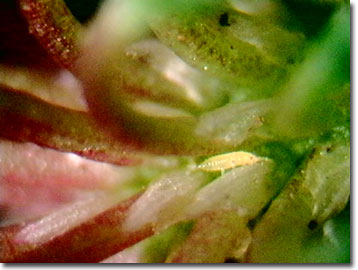Reflected Light Digital Image Gallery
Aphid in Clover
Aphids, also known as plant lice, are insect pests and disease vectors annually responsible for millions of dollars in crop damage. Clovers (Trifolium species), such as the yellow, red, white, and sweet clovers, used as range food and harvested as hay, are not immune to the sap suckers.

As part of the order Hemiptera in the class Insecta, aphids are true bugs featuring sucking mouthparts. There are more than 4,000 species of aphids worldwide, with about 250 identified as serious pests. Often parthenogenetic, aphid species demonstrate both viviparity (live birth) and oviparity (egg laying). In an unusual strategy, which recalls the nested Russian matryoshka dolls and that allows incredible population growth and a rapid turnover of generations, some female aphids are capable of "telescoping" by not only carrying embryos of her developing daughters, but also of her grand-daughters, which are developing within her unborn daughters. Presented in this micrograph is a nymph of an unidentified aphid collected on a wild clover in Tallahassee, Florida.
Aphids produce honeydew, an excretion of sugary liquid, which results from feeding on the plant saps that are rich in sugars and poor in amino acids and protein. Other insects such as the brown hairstreak butterfly, common wasps, and some ant species feast on the honeydew, while offering protection to these vampires of the plant world.
In Northern Florida, arrowleaf, red, crimson, and white clover are grown commercially as forage crops, ground cover, and as nitrogen-fixers, and are used to replenish depleted soil nutrients in rotation with plantings of other demanding crops. Wildlife such as white-tailed deer and bobwhite quail use fields planted in clover cover crops as feeding and resting habitat. Integrated pest management practices include strip intercropping vegetables with clover-alfalfa mixtures to divert pests such as aphids away from the vegetables, while reducing costs and health risks associated with pesticide use.
Contributing Authors
Cynthia D. Kelly, Thomas J. Fellers and Michael W. Davidson - National High Magnetic Field Laboratory, 1800 East Paul Dirac Dr., The Florida State University, Tallahassee, Florida, 32310.
BACK TO THE REFLECTED LIGHT IMAGE GALLERY
BACK TO THE DIGITAL IMAGE GALLERIES
Questions or comments? Send us an email.
© 1995-2022 by Michael W. Davidson and The Florida State University. All Rights Reserved. No images, graphics, software, scripts, or applets may be reproduced or used in any manner without permission from the copyright holders. Use of this website means you agree to all of the Legal Terms and Conditions set forth by the owners.
This website is maintained by our
Graphics & Web Programming Team
in collaboration with Optical Microscopy at the
National High Magnetic Field Laboratory.
Last Modification Friday, Nov 13, 2015 at 02:19 PM
Access Count Since September 17, 2002: 11757
Visit the website of our partner in introductory microscopy education:
|
|
